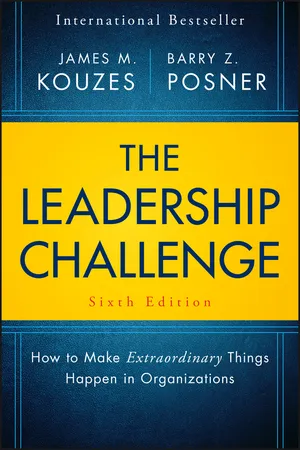
The Leadership Challenge
How to Make Extraordinary Things Happen in Organizations
James M. Kouzes, Barry Z. Posner
- English
- ePUB (mobile friendly)
- Available on iOS & Android
The Leadership Challenge
How to Make Extraordinary Things Happen in Organizations
James M. Kouzes, Barry Z. Posner
About This Book
The most trusted source of leadership wisdom, updated to address today's realities
The Leadership Challenge is the gold-standard manual for effective leadership, grounded in research and written by the premier authorities in the field. With deep insight into the complex interpersonal dynamics of the workplace, this book positions leadership both as a skill to be learned, and as a relationship that must be nurtured to reach its full potential. This new seventh edition has been revised to address current challenges, and includes more international examples and a laser focus on business issues; you'll learn how extraordinary leaders accomplish extraordinary things, and how to develop your leadership skills and style to deliver quality results every time. Engaging stories delve into the fundamental roles that great leaders fulfill, and simple frameworks provide a primer for those who seek continuous improvement; by internalizing key insights and putting concepts into action, you'll become a more effective, more impactful leader.
A good leader gets things done; a great leader aspires, inspires, and achieves more. This book highlights the differences between good and great, and shows you how to bridge the chasm between getting things done and making things happen.
- Gain deep insight into leadership's critical role in organizational health
- Navigate the shift toward team-oriented work relationships
- Motivate and inspire to break through the pervasive new cynicism
- Leverage the electronic global village to deliver better results
Business is evolving at an increasingly rapid rate, and leaders must keep pace with the changes or risk stagnation. People work differently, are motivated differently, and have different expectations today—business as usual is quickly losing its effectiveness. The Leadership Challenge helps you stay current, relevant, and effective in the modern workplace.
Frequently asked questions
Information
Table of contents
- Cover
- Praise for The Leadership Challenge, Sixth Edition
- Title Page
- Copyright
- Introduction: Making Extraordinary Things Happen in Organizations
- What Leaders Do and What Constituents Expect
- Practice 1: Model the Way
- Practice 2: Inspire a Shared Vision
- Practice 3: Challenge the Process
- Practice 4: Enable Others to Act
- Practice 5: Encourage the Heart
- Acknowledgments
- About the Authors
- Index
- End User License Agreement